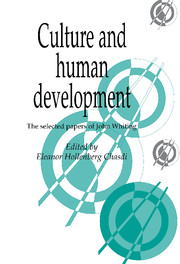Book contents
- Frontmatter
- Contents
- List of figures
- Preface
- Acknowledgments
- Introduction: John Whiting and anthropology
- Fifty years as a behavioral scientist: autobiographical notes
- Part I Theory and methods
- Introduction
- 1 Contributions of anthropology to the methods of studying child rearing
- 2 The cross-cultural method
- 3 A model for psychocultural research
- Part II Environment and history
- Part III Moral development
- Part IV Gender development
- Part V Development of social behavior
- Bibliography
- Complete bibliography of John W. M. Whiting's work
- Index
3 - A model for psychocultural research
Published online by Cambridge University Press: 23 December 2009
- Frontmatter
- Contents
- List of figures
- Preface
- Acknowledgments
- Introduction: John Whiting and anthropology
- Fifty years as a behavioral scientist: autobiographical notes
- Part I Theory and methods
- Introduction
- 1 Contributions of anthropology to the methods of studying child rearing
- 2 The cross-cultural method
- 3 A model for psychocultural research
- Part II Environment and history
- Part III Moral development
- Part IV Gender development
- Part V Development of social behavior
- Bibliography
- Complete bibliography of John W. M. Whiting's work
- Index
Summary
Over the years, my colleagues and I have developed the so-called Whiting Model for psychocultural research (figure 3). This is a heuristic model, and can serve here as a map showing how each of the studies that I will mention relates to all the others.
The arrows in the model represent assumptions about the direction of causation. It should be emphasized that we are dealing with assumptions, not laws or axioms. In some, if not many, instances, the true direction of causation may be the reverse: there may be feedback loops and steps in the assumed sequence may be skipped. The arrows do, however, represent a commonly occurring sequence. The primary reason for making such over-simplified assumptions about causation is that they give rise to a readily testable set of hypotheses. Hypotheses that are difficult or impossible to put in jeopardy are not, in my opinion, very fruitful. Progress in any science is most rapid when an accepted hypothesis is shown to be false, and a new search for truth begins.
It would be impossible to review here even a reasonable sample of the research bearing on the various parts of the model. I will, however, briefly describe a few studies that will, I hope, serve to illustrate the model and elucidate the basic assumptions latent in it.
Most ethnological disciplines make either implicit or explicit assumptions about the needs, drives, and capacities of the individual. Economic anthropology assumes a need for sustenance and shelter. Political anthropology makes certain assumptions about strivings for power and prestige.
- Type
- Chapter
- Information
- Culture and Human DevelopmentThe Selected Papers of John Whiting, pp. 89 - 102Publisher: Cambridge University PressPrint publication year: 1993
- 1
- Cited by



